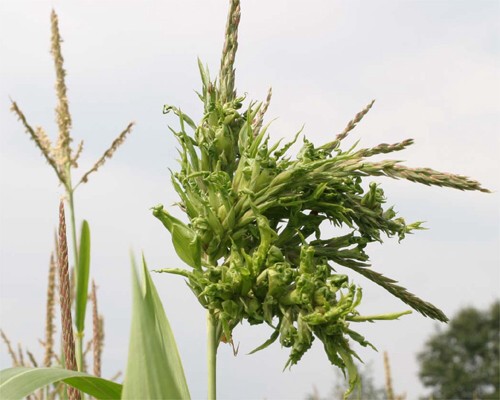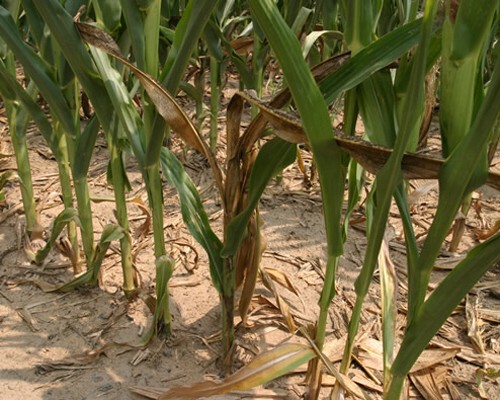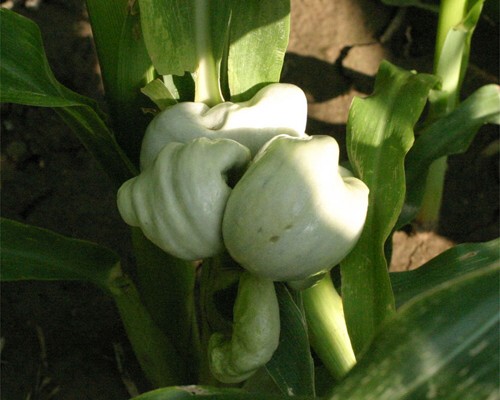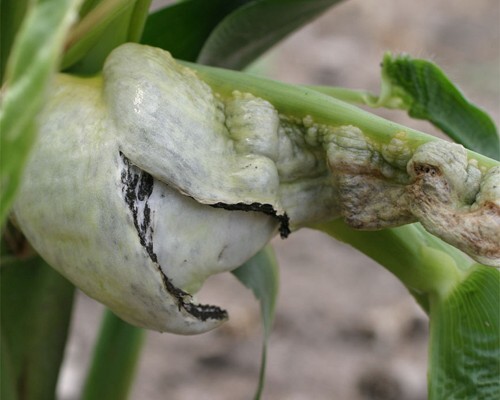Published 10 June 2008
URL: http://www.kingcorn.org/news/articles.08/FloodingDisease-0610.html
Recent Weather May Promote Unusual Disease Problems in Corn
Greg Shaner
Botany & Plant Pathology Dept., Purdue Univ.
West Lafayette, IN 47907-2054
Email address: shanerg
at purdue.edu
- High water creates conditions for crazy top and bacterial stalk rot
- Strong winds can lead to corn smut
Excessive rain and strong winds during the past 2 weeks may result in diseases that are normally minor issues for corn: crazy top, bacterial stalk rot, and smut.
Crazy top belongs to a class of diseases known as downy mildews. The most conspicuous symptom of crazy top is a leafy proliferation in place of the normal tassel. Infected plants tiller excessively. Leaves are only about one-third normal width. Leafy bracts may develop on the ears. Plants may be severely stunted. Most importantly, infected plants are usually barren. A fungus-like organism, Sclerophthora macrospora, causes crazy top. This organism infects several grasses, including crabgrass, barnyard grass, goose grass, green foxtail, love grass, smooth brome, quack grass, and witch grass, that may be along field edges. These grass hosts are probably the source of spores that infect corn. That is why crazy top usually appears only on corn near field edges. Sclerophthora produces oospores in infected tissue. These spores overwinter. When soil is saturated or flooded for at least a couple of days, oospores germinate to produce a sporangium, which in turn releases small, motile zoospores. Zoospores that come in contact with corn or some other host plant encyst and then infect. Corn is most vulnerable to infection when young. When Arni Ullstrup described this disease in 1955, he observed that when plants were over 1 ft tall when flooded, crazy top did not develop. The delays in planting corn this spring, and the cool weather that slowed growth of corn, means that many ponded fields are still at a vulnerable growth stage.

Crazy top symptoms on the tassel. Most of the tassel has been replaced by
a leaf proliferation.
Flooding also increases risk of bacterial stalk rot. Erwinia carotovora pv. zeae causes this disease. The bacterium survives in aboveground corn residue. It infects corn when contaminated water moves into whorls of young plants. The bacterium produces a soft rot at the base of the whorled leaves. These leaves become yellow, then brown, and they can be pulled out of the whorl easily. The bacterium invades the growing point and produces a soft, often foul-smelling rot. We have seen this disease in previous years where corn was sprinkler-irrigated from ditch water or where corn was briefly inundated by floodwater. The warm and excessively wet weather of the past few days may lead to outbreaks of bacterial stalk rot in fields where water covered the whorl. Temperatures in the range of 90 to 95F are most favorable for the disease, and we have experienced these over the past few days. Where floodwater recedes quickly enough that corn does not die outright, this disease may develop. Not every plant that is flooded will develop the disease, but the incidence may be high enough to reduce yield.

Bacterial stalk rot. Above two green leaves on the plant in the center of
the picture, all leaves are dead.
The rot has progressed down into the crown tissue. Even though all plants
in this field were
exposed to contaminated irrigation water, only some became infected.
Soil particles carried by strong winds during the past several days may have caused microscopic wounds to young corn plants, which will allow spores of the common smut fungus (Ustilago maydis) to infect. Teliospores of the fungus survive several years in soil, and the fungus appears to be widespread in Indiana. It is possible to find a few smutted corn plants in any field that is walked, but the incidence of infection is usually so low there is no economic damage. However, very susceptible hybrids may develop a high incidence of smut and suffer considerable loss. Last year I looked at a field planted to four different hybrids. In one hybrid, 50% of the plants had smut galls. This was before ears had emerged. The galls were on the lower stem and so large they had broken the stalks over. The other three hybrids had smut, but at much lower incidence, and galls were small and mainly on leaf blades.
Spores infect stems and leaves through microscopic wounds. The fungus may also grow down silks and infect developing kernels, which results in ear galls. Initially the galls are smooth and white. Later, the interior of the gall becomes a mass of black spores, and then the covering white tissue disintegrates to release the spores. Wet weather is thought to favor spore production and infection. With the strong winds we have had recently, followed by humid weather, we may see more than the usual amount of smut on corn.

Young gall on the lower stem of a susceptible hybrid.

Older gall on lower stem of a susceptible hybrid. Black spores are starting
to break through the white covering.
Note that the stalk is bent over at a right angle.

